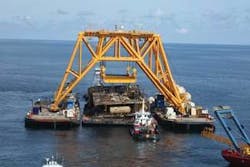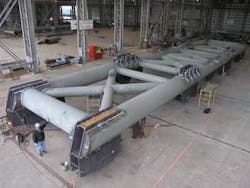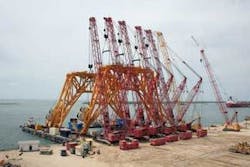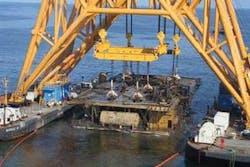Versabar invention lifts submerged topsides in one piece
David Paganie, Managing Editor
More than 123 gravity-based platforms in the Gulf of Mexico were destroyed by hurricanes Ivan, Katrina, and Rita. In some cases, the platforms’ jackets and decks were toppled and completely submerged. The MMS requires operators to clear the debris in one of two ways: deploy the platform in or near its resting place as an artificial reef (typically the first and least expensive option), or lift the wreckage (in small pieces, or single piece/single lift) and transport it to shore.
One of the difficulties in salvaging a plat- form’s topside is determining its actual structural condition before the lift. The facility’s jacket usually is cut into pieces by divers and sent to shore. To mitigate this challenge, with removal demand elevating after Katrina and Rita, Jon Khachaturian, president of Versabar, began designing a new heavy-lift system. Twelve months later, following model testing at Offshore Model Basin in Escondido, California, the patented Bottom Feeder was introduced. At print, the device had been used to lift four hurricane-toppled decks.
null
Deck removal challenges
“Deck removal by a conventional derrick barge with one single hook is problematic,” Khachaturian says. “The one-hook setup really limits you. Topsides come up in different angles, and you have minimal side load capacity with the average crane, so you risk pulling sideways.”
Technical challenges with the traditional (one hook) deck removal approach include uncertainty of the structure’s condition post collapse, its deck weight and center of gravity, its seabed penetration, which increases the initial lift-off weight because of friction, and the topside’s performance as it transits the water column through the surface.
There are also safety and environmental challenges. The unstable deck equipment and materials are hazardous to divers during demolition and the lift. Small piece removal of the deck can permit the release of hydrocarbons in an uncontrolled environment. And the recovery of multiple large components and pieces of equipment to the surface require careful lift planning and handling.
The primary challenge on the removal schedule with the traditional technique is dealing with the weather over a longer period of time (weeks and months) versus hours with the Bottom Feeder. With the single hook, it may be necessary to maintain a large offshore spread over an extended period of time.
Alternative single piece lift
The Bottom Feeder is designed to lift decks from the seafloor in one piece. It is equipped with capacity to lift 4,000 tons (3,629 metric tons) in up to 400 ft (122 m) of water, and requires about 1/3 the capital needed to build a conventional crane barge with similar capacity. “The limitation is governed by the amount of wire we have on our winch drum, and we can add more if we want,” Khachaturian says. It has four independent pairs of lift blocks with a rated capacity of 1,000 tons (907 metric tons) each. This provides an excellent degree of control during lifting operations, according to Versabar. That is an essential requirement for lifting large structures when accurate weight data is not available, and some units are resting on the seabed off-level.
The lift system consists of two rigid space frame truss structures connected by hinged supports on the centerlines of two deck transport barges, measuring 250 ft (76 m) x 72 ft (22 m). “I had worked for years off of two barges, which gives you great stability,” Khachaturian says. “They key to this invention is that there’s a wide side on one barge and a universal joint on the other, and then vice-versa - basically two inverted triangles. This is important because the two barges can pitch out of sync - they are hydrodynamically decoupled,” he says.
The support hinges decouple the heave, pitch, and roll motions of the support barges from the lift structures. The structural design of the system was based on dynamic loads that can be generated by wave action when lifting structures both under water and through the water surface. This allows the system to remain stable under transit and lifting conditions.
Lifting is completed via application of the four independent pairs of lift blocks, which have 45 ft (14 m) by 80 ft (24 m) spacing. This provides flexibility to efficiently distribute lift loads into the structure, accommodate structures that are off-level at the time of lift, and handle loads with an unknown lift weight and center of gravity location. The blocks can be operated synchronously or independently.
The 3D space frame nature of the structure provides out-of-plane or side-load capacity, allowing for structures that initially lift out-of-level to be lifted and re-leveled during the process without the need to re-rig. The pattern of support hinges results in a skewed-loading damping effect, reducing the possibility of overloading one lift point during lifting operations.
The use of four independent lifting blocks also provides rigging flexibility when compared to a single, high-capacity hook. It reduces the amount of height required to rig the topsides, allowing the decks to be lifted clear of the water while minimizing the hook height.
The geometry of the single lift system is such that a typical GoM eight-pile jacket and deck can be lifted clear of the water and set directly onto a cargo barge for transportation to shore for decommissioning. The clearance between the support barges is approximately 110 ft (34 m) at the water line. This allows a deck barge measuring up to 400 ft (122 m) x 100 ft (30 m) to be maneuvered safely between the support barges, and the salvaged topsides to be lowered and set onto a temporary grillage.
Preparation
Each deck is prepared for lift prior to the arrival of the lift system in-field. Versabar pre-fabricated rigging assemblies are lowered to the deck structure and tied into the main truss row frames; six to eight are required to complete a single deck recovery. These hook assemblies permit rapid, diver-less rig-up and de-rig of the system from the deck to ensure safe, efficient recovery.
With the lift system on location, an eight-point mooring is set, and the system is positioned over the deck to be recovered. The four lift blocks and deck rigging are lowered into the water. With ROV assistance, the rigging/slings are maneuvered into the pre-set hook assemblies. Once all hooks are confirmed, the lift can begin. The deck is then lifted to the surface and lowered onto a cargo barge for transportation. Any hydrocarbons or liquids released during the lifting process are captured between the two system barges by boom. The armored deck barges also are fitted with a pollution containment and recovery system to capture any potential hydrocarbon tainted liquids before tow to shore.
The lift
Versabar was called in to salvage four hurricane-toppled platform topsides (three from Ivan and one Katrina) from the seabed. Before lifting, an ROV video survey was conducted allowing Versabar engineers to choose locations on the deck for the underwater hooks. Saturation divers, who were plugging the wells and dismantling the jackets, cut holes in the top of the decks and installed the hooks built and tested by Versabar.
The day of each lift, rigging was dropped with loop slings. An ROV assisted with their connection to the hooks. Each of the eight-leg topsides was retrieved intact in a single lift with peak lift weights up to 1,600 tons (1,451 metric tons). Recovery of all four decks was completed in 18 days. Less than 12 hours lapsed from the initial hookup to the first deck to when the cargo barge departed the site with the recovered topside on board.
The company also used its new subsea trash basket, measuring 160 ft (49 m) x 45 ft (14 m) x 20 ft (6 m), to collect and remove in one lift small pieces of debris that were difficult to handle as a single piece from seabed to surface.
Next generation
With an expected backlog of 10 or 12 more deck lifts and apparent demand for this type of device to perform topside installations, Versabar is going back to the drawing board on options for a second Bottom Feeder. The next one, Khachaturian says, could be about twice as tall and one and a half times wider than the original with capacity to lift 5,000 tons (4,536 metric tons). “With these design parameters, you can slide over platforms, set or remove a large module, or remove an entire topside in one piece,” he says. Other possible applications include deepwater jumper and subsea manifold lowering and installation.
Demand and performance will dictate how many of these systems are built. With many years of hurricane-related cleanup to go and a lot of dead iron in the Gulf, look for more of these innovative salvage devices, which, based on its first job, saves the customer time and money.
The MMS requires removal of all non-producing structures in the Gulf of Mexico on inactive leases within one year from cessation of production. According to the MMS, at the end of 2003, 1,227 facilities in the Gulf were idle, 329 on inactive leases.




